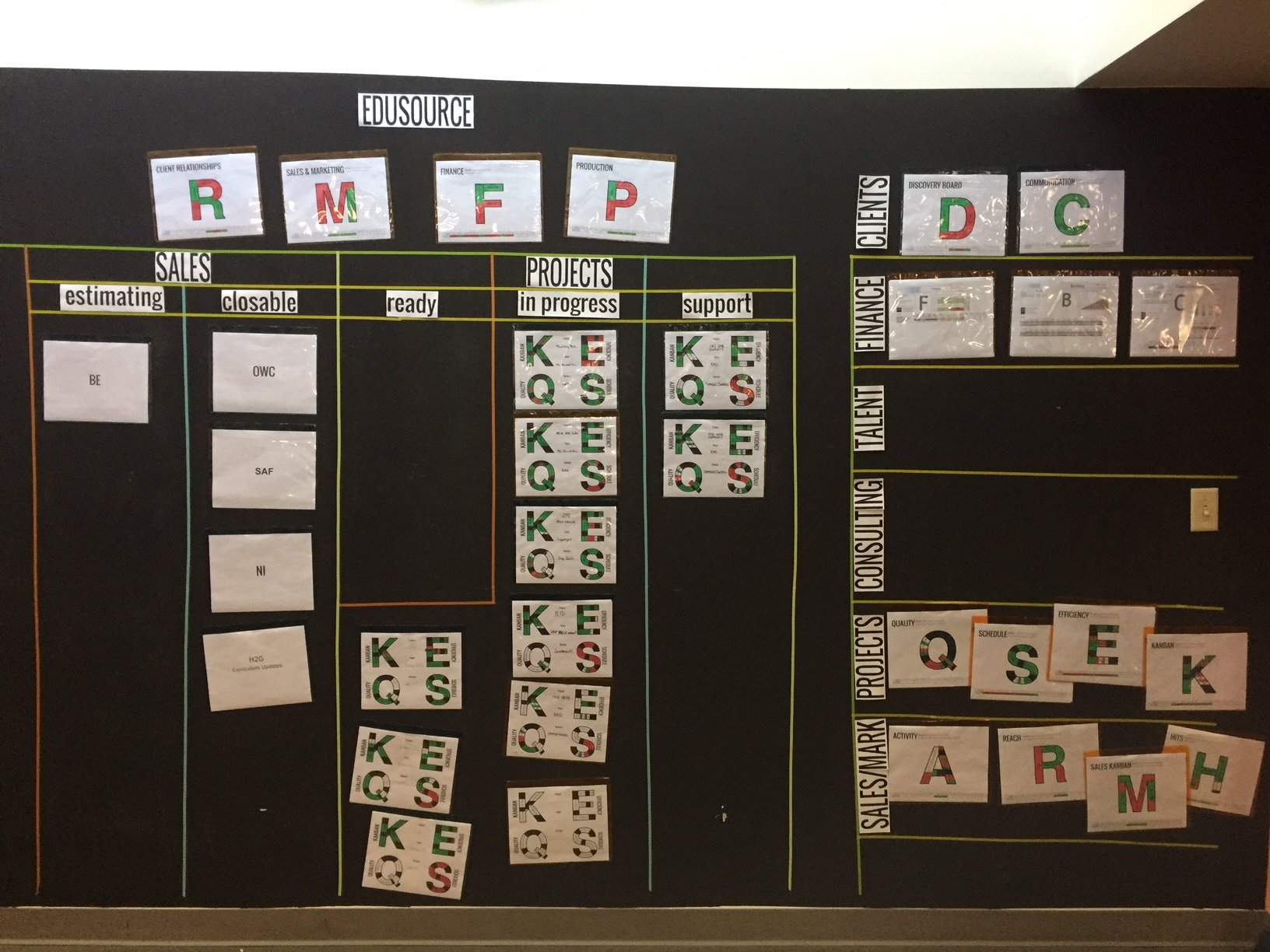In an industry that is known for missed deadlines, a 96% on-time delivery rate gets attention. We often have potential clients ask: How do you do that?
At RoboSource, we achieve a 96% on-time delivery rate through a process called Daily Layered Accountability (DLA).
Before I get into it, I want to give a shout out to the team who led us on this path: Enable. If you want to do something similar – in any kind of business – give them a call. They will help you tailor DLA to fit your needs. And they are just plain great people to work with.
 Here’s how it works:
Here’s how it works:
Every area of the company has measurable metrics.
For our project teams, one of these is “S” for Schedule. Each morning, a mathematical calculation automatically runs and figures this and other project metrics, letting our team know if they are on schedule to delivery date. The really great thing about this metric? It’s predictive, so it tells our teams if a User Story is likely to become overdue if they continue working on it at the pace they are currently. That way, they have a chance to work late or pull in another resource to get things caught up if necessary.
Our teams meet each morning and take note of their calculated DLA scores and color their project’s letters accordingly. For instance, if the team’s “S” is showing up red, that means that the project is trending behind schedule. When a red shows up in any area, teams do a quick root cause analysis to explain why they aren’t meeting expectations on schedule, quality, efficiency, cost, or Kanban. If they feel like they need help or advice, they escalate issues on their online DLA pages. (Most metrics have both online and printed DLA pages. The online versions have more info, but we like that we can get a feel for how things are going at a glance on this wall.) You can see these printed project pages in the photo above, under the “Projects” heading.
Once a month, teams look back at all the root causes and make plans to fix those that occur most often. Or they look for low-hanging fruit, those that they can fix easily or quickly.
Other areas of the company have metrics, too. For Marketing, for instance, we measure website hits. (So thanks for reading this – you’re helping my daily number!) For Clients, we measure number of touches. Every area of the company gets together in a timeframe that makes sense – we measure web hits in a meeting three per week, but only do a deep dive into finances once a week.
Then we roll them up.
That’s where the “Layered” comes into DLA.
For our project area, we have a daily roll-up meeting. Various project team leaders meet together and look for problem areas and make quick corrections to get things back on track as needed. They pull in team members to gather more info. They make sure reds are isolated and not the norm for a project. They make resourcing adjustments as needed to keep things on track.
You can find some of our roll-up metrics on the right-hand side of the photo above.
And then we roll it up again.
Once a week, our Leadership Team convenes for what we call Weekly Layered Accountability (WLA). In this meeting, each area of the company presents how the week has looked metric-wise. I present about web traffic and our reach for the week. Sales talks numbers of meetings and overall activity. Production looks at how the project work has gone over the whole week. Sometimes, this can be a depressing meeting. Last week, one of our biggest clients decided to pay us several weeks late, so our “F” (for Finances) metric went red. But often, it’s a reassuring meeting, in which we walk out knowing that things are under control and going as expected.
In the photo above, you can find those weekly roll-up metrics at the top of the wall under the word “RoboSource.” (Note that last week was a holiday week, so some of these weren’t updated. We’re working on making sure that doesn’t happen again.)
These metrics are sacred to us.
Since we have built a business model on working with young students, we believe it is absolutely imperative to watch these metrics closely. It’s easy to get lazy with them, especially when something hasn’t changed for awhile – good or bad. As company leaders, we have to tout the importance of these metrics over and over again. We also have to celebrate small wins. If we’re having a rough stretch with projects, we’ll throw down a challenge: if all teams are green on the same day, the company will buy pizza.
We keep improving the metrics.
One of our Core Values is Kaizen, which is a Japanese philosophy of continuous improvement. Because of that value, no matter how frustrating it is, we improve metrics whenever we become convinced that’s there’s a better way to measure something. Our plan is always to get started measuring something, with the expectation that we’ll refine those metrics as we go along. (You’ll see in the photo above that the “Talent” area is still blank. We’ve got lots of ideas about how to measure that, but haven’t settled on what to start with yet. Sometimes it’s challenging to find something that can be easily measured on a daily or weekly basis. Let us know if you have ideas!)
That’s our DLA process, which is the reason we can boast a 96% on-time delivery rate. Have questions? Email info@robosource.us, and we’ll set up a time for you to see the process in person. Or ask them below. Thanks for reading!


Recent Comments